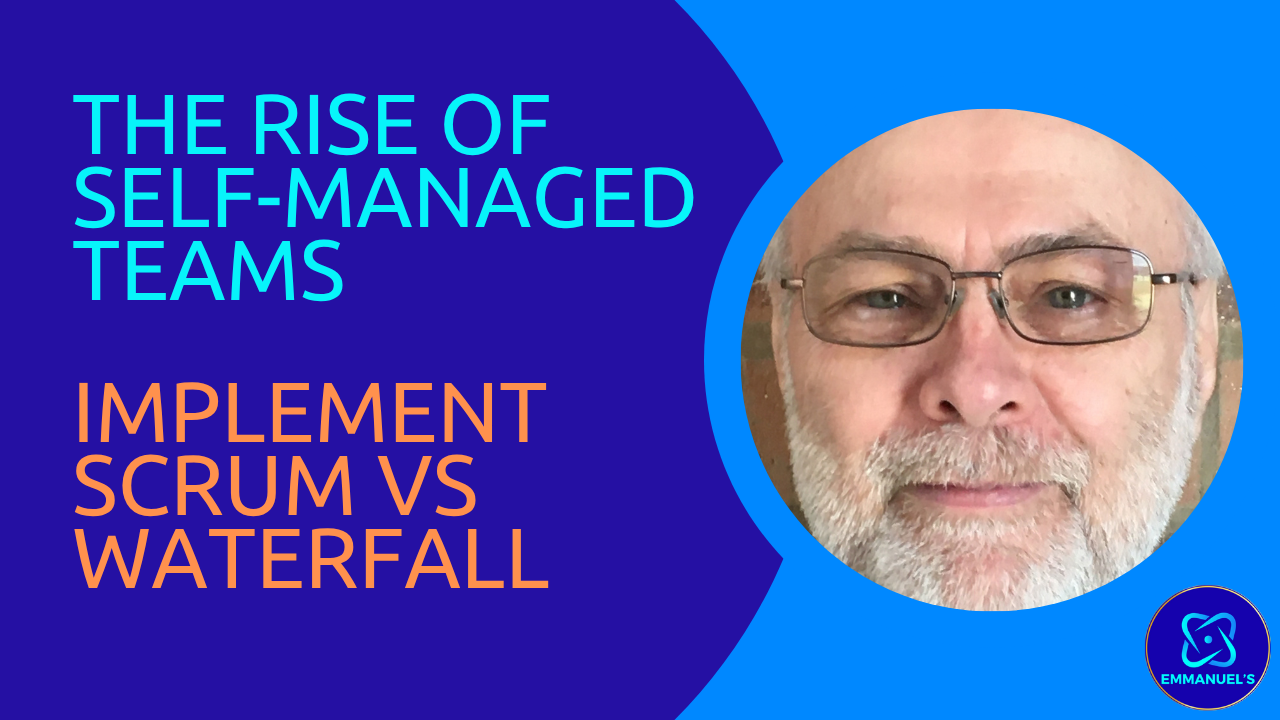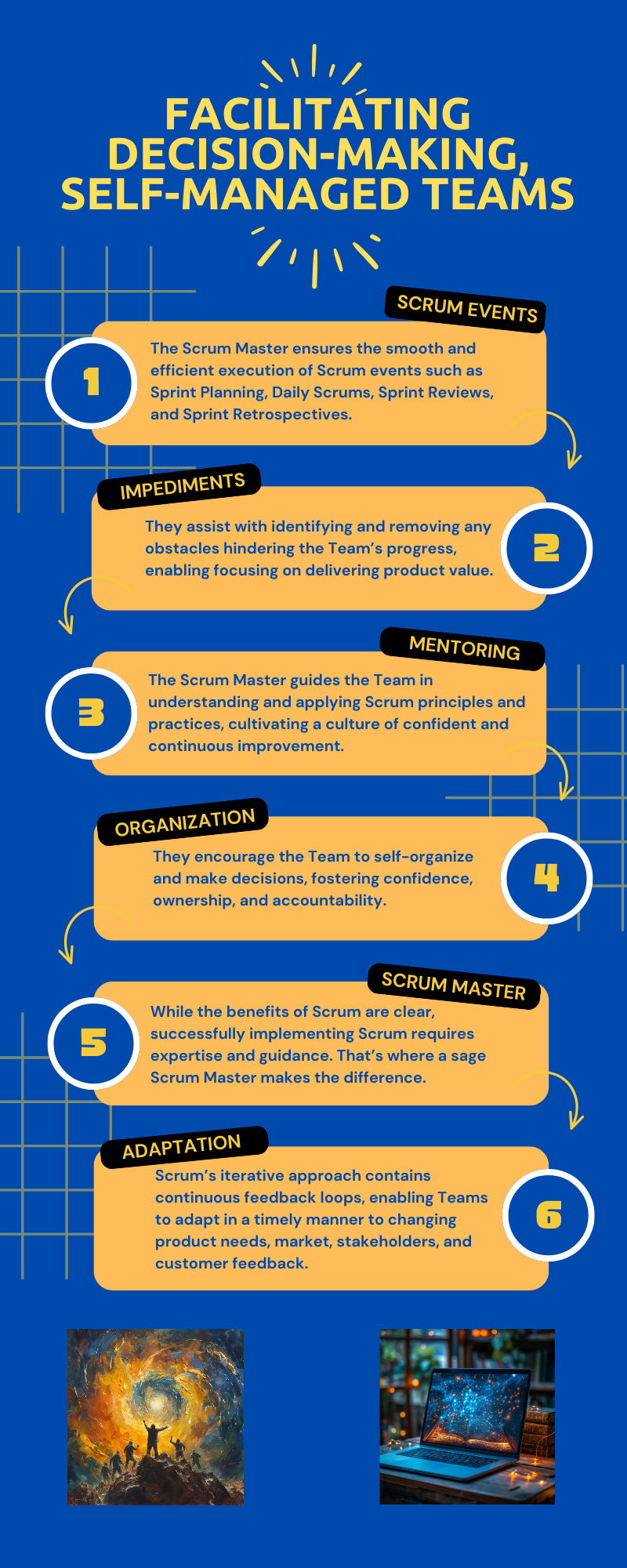The Rise of Self-Managed Teams: Choose Scrum vs Waterfall
Explore the rise of a self-managed Team! How do autonomy, decision-making, and self-managing teams efficiently deliver product value and make decisions?

How are self-managed teams and Agile methodologies like Scrum transforming project execution in our complex, fast-paced business environment?
The need for Agile methodologies has prompted organizations to rethink traditional project management approaches. At the forefront of this transformation is the role of the Scrum Master, a pivotal figure in the realm of Agile frameworks.
Scrum Master vs Traditional Project Management: Self-managed Teams
Unlike traditional project managers, who usually dictate tasks and timelines, Scrum Masters encourage teams to self-manage and to take ownership of their work, fostering collaboration and adaptability. This shift enhances Team morale and accelerates project delivery while embracing iterative processes.
As organizations increasingly recognize the benefits of agility, understanding the differences between Scrum Masters and traditional project management becomes essential.
Here we delve into the contrasting philosophies, roles, and practices of Scrum Masters and traditional project managers, highlighting how self-managed teams thrive in the dynamic landscape of modern project execution.
Join us as we explore the implications of this evolution on Team dynamics, project outcomes, and overall organizational success.
The Rise of Self-Managed Teams: Choosing Scrum vs Waterfall, Rethink Waterfall
Scrum Master vs Traditional Project Management
A well-structured project often involves comprehensive planning; every detail is carefully assessed and planned, and each milestone is clearly defined. This meticulous approach ensures that the project’s objectives are systematically achieved and helps track progress effectively.
Yet, as the project progresses, unforeseen challenges arise, market demands shift, and the initial plan becomes outdated.
This scenario is often seen in traditional project management–what if there were a way to embrace change, adapt to evolving needs, and consistently deliver value?
Is your project management approach—whether Scrum or traditional—delivering efficient business value? Or is it hindering your ability to innovate and respond to market changes? Enter Scrum–your market differentiator.
Scrum is an Agile framework that offers a flexible and efficient project management approach. It enables teams to navigate complexity and deliver efficient results.
We explore the benefits of using Scrum and a Scrum Master, contrast it with traditional project management, and highlight its relevance for product owners, CEOs, stakeholders, and project managers.
What is Scrum?
Scrum is an Agile framework that guides teams to address complex adaptive problems while productively and creatively delivering high-value products.
Scrum employs a methodical approach, breaking down tasks into manageable cycles known as Sprints. Initially, the Scrum Team decides on the duration of a Sprint, which is between one and four weeks. During these Sprints, teams focus on specific goals for iterative development and continuous improvement as they progress.
Each Sprint involves a defined set of goals and deliverables, with the Team working collaboratively to achieve them. At the heart of Scrum is the Scrum Master, who facilitates, guides, and supports the Team and the stakeholders.
Why Choose Scrum With Self-managed Teams Over Traditional Project Management?

While traditional project management methodologies like Waterfall rely on detailed upfront planning and exacting execution, Scrum embraces change and adaptability. Adaptability makes it ideal for projects with evolving requirements or uncertain outcomes.
Here’s a closer look at the key advantages of Scrum:
Efficiency
Scrum encourages self-organizing teams and entrusts individuals to take ownership of their work, leading to efficient delivery cycles.
Collaboration
Daily Scrum meetings, Sprint Reviews, Retrospectives, and Planning foster communication and collaboration among Team members and stakeholders, ensuring everyone is aligned and working towards a common goal.
Adaptability
Scrum’s iterative nature encourages continuous feedback and adjustments throughout the project lifecycle, enabling teams to respond timely to changing requirements and market demands.
Mitigate Risk
By delivering work in short Sprints, Scrum enables early detection and mitigation of risks, minimizing potential project failures.
High Quality
Continuous testing and feedback loops built into the Scrum process ensure product quality and customer satisfaction. Additionally, with Scrum, the Team is facilitated to foster a sense of ownership and accountability.
Transparency
All stakeholders have visibility into the project’s progress, Backlog, and potential obstacles and roadblocks, cultivating trust and accountability.
People over Processes
Unlike traditional project management, which emphasizes a process-centric approach, Scrum prioritizes people. This shift in focus entrusts individuals, fosters collaboration, and promotes an adaptable and responsive work environment.
Iterative Decision-Making
Scrum utilizes an iterative approach to decision-making, enabling flexibility and adjustments based on real-time data and feedback.
Traditional project management often relies on a fixed scope defined upfront, making it less adaptable to change.
Delivering Product Value With Each Sprint
A key benefit of Scrum is that it focuses on delivering usable product increments with each Sprint. Sprints provide stakeholders with tangible results, early feedback, and validation, unlike traditional methods, which typically deliver a usable product only at the end of a phase or project.
When Not to Use Scrum
While Scrum offers numerous advantages, it may not be suitable for all projects.
Consider these factors before adopting Scrum:
- Team Size: Scrum is most effective with small, dedicated teams (typically 3 to 9 members). Larger teams may require scaling frameworks like Scrum of Scrums or LeSS.
- Project Complexity: Scrum excels in complex projects with evolving requirements, while traditional methods suffice for simple, well-defined projects.
- Team Collaboration: Scrum requires active participation and collaboration from all Team members. If the Team lacks communication or struggles with collective decision-making, Scrum would not be effective.
What Does Self-managed Teams Mean?
A self-managed Team operates with a high degree of autonomy, allowing its members to work autonomously without the need for direct supervision. Unlike a traditional Team, where a manager oversees tasks and responsibilities, a self-managing Team consists of members who collaborate closely to take full ownership of their work.
The rise of self-managed teams reflects a growing trend toward flatter organizational structures that emphasize engagement and accountability. These teams often have unique advantages, such as efficiency and enhanced problem-solving capabilities, as members are encouraged to contribute to decision-making processes.
However, self-managed teams also have disadvantages. Not all groups may be suitable for a self-managed Team structure, as some teams include members who may struggle with self-direction or lack the necessary skills for effective collaboration.
Additionally, self-managed teams don’t always guarantee transparent discussions, as uncertainty and unclear outcomes could arise without a sage leader to mediate. Ultimately, the effectiveness of a self-managed Team hinges on its members’ ability to work together and navigate challenges collectively.
What Best Describes a Self-managed Team?
A self-managed Team is a group of Team members who operate with a high degree of autonomy, taking on responsibilities typically held by managers and stakeholders. These teams make decisions collectively, allowing for flexibility and creativity in problem-solving.
While self-managed teams offer numerous benefits, such as confidence and faster decision-making processes, they also encounter obstacles and challenges.
For instance, teams may struggle with conflicts or a lack of direction without a designated leader.
Despite these potential pitfalls, self-managed teams enhance collaboration, creativity, and innovation within an organization. They encourage Team members to take ownership of their work and foster responsibility and accountability.
However, it’s essential to recognize the disadvantages of self-managed teams, such as the need for transparency, communication skills, and the risk of becoming insular.
Ultimately, teams that navigate these challenges effectively create a dynamic and responsive work environment.
The Scrum Master: Facilitating Decision-making, Self-managed Teams

Traditional project managers emphasize strategic oversight and centralized decision-making.
The Scrum Master guides and supports the Team in achieving its goals. Their key responsibilities include:
- Facilitating Scrum Events: The Scrum Master ensures the smooth and efficient execution of Scrum events such as Sprint Planning, Daily Scrums, Sprint Reviews, and Sprint Retrospectives.
- Removing Impediments: They assist with identifying and removing any obstacles hindering the Team’s progress, enabling them to focus on delivering product value.
- Coaching and Mentoring: The Scrum Master guides the Team in understanding and applying Scrum principles and practices, cultivating a culture of continuous improvement.
- Fostering Self-Organization: They encourage the Team to self-organize and make decisions, fostering confidence, ownership, and accountability.
- Implementing Scrum: While the benefits of Scrum are clear, successfully implementing Scrum requires expertise and guidance. That’s where a sage Scrum Master makes the difference.
- Transparency, Inspection, and Adaptation: Scrum’s iterative approach contains continuous feedback loops, enabling teams to adapt in a timely manner to changing product needs, market, stakeholders, and customer feedback. The Scrum Master guides and facilitates this agility, which translates to getting to market sooner, customer satisfaction, product quality, and having a market differentiator. By focusing on short Sprints and continuous improvement, Scrum enables teams to deliver product value incrementally.
Employee Engagement And Self-Management In The Workplace

Employee engagement is essential in fostering a productive Team, particularly within a self-managed Team. This type of Team is a group of employees who work collaboratively and autonomously, allowing them to make decisions that directly impact their tasks and goals.
The characteristics of self-managed teams include shared responsibility, mutual accountability, and the ability to set their objectives, which enhances delivering product value and job satisfaction. However, self-managed teams aren’t without challenges, especially in a flat organizational structure or during remote work.
Fostering an environment where employees who work independently support each other enables the entire Team to work together to achieve efficient results.
How to Foster Self-managed Teams
Implementing self-managed teams requires a shift from traditional management practices to an empowering organizational structure. A successful self-managed Team thrives on autonomy, allowing a group of employees to take charge of their decision-making process.
To assemble self-managed teams, organizations should focus on employee engagement by providing mentoring that fosters transparency, communication, and collaboration within the Team.
It includes facilitating conflict resolution techniques and encouraging problem-solving as a collective effort. Companies like Zappos have embraced self-directed teams, which have increased Team performance and overall employee satisfaction.
Nonetheless, the change might come with drawbacks. Self-managed teams may not suit every workplace, as they necessitate a considerable degree of self-regulation and dedication from each Team member.
Consider all Team members. Teams should alternate leadership roles to maintain high engagement, ensure cross-functionality, and incorporate diverse perspectives.
While self-managed teams empower employees, it’s crucial to establish a Team structure that aligns with the organization’s goals.
By fostering a culture of open communication and shared responsibility, businesses unlock the benefits of self-managed teams while mitigating obstacles and challenges.
Scrum Roles and Responsibilities
Scrum defines three primary roles, each with distinct responsibilities:
Product Owner
The product owner represents the customer and stakeholders, defines the product vision, manages the product backlog, and prioritizes features and MVPs.
Scrum Master
Facilitates the Scrum process, assists with discovering, identifying, and removing impediments, and coaches the Team and stakeholders in Scrum practices.
Development Team As A Self-managed and Cross-functional Team
In our Agile environments, self-managed teams are becoming increasingly popular.
These teams are groups of employees that operate with a high degree of autonomy, allowing them to take ownership of their work. Self-managed teams make decisions collaboratively, fostering an innovative culture.
Teams are typically cross-functional, bringing together diverse skills to deliver complex projects. When well-structured, teams deliver value with efficiency.
A cross-functional Team is best suited for delivering the product increments.
Seasoned and Confident Self-managed Teams
Self-managed teams represent a progressive approach to organizational structure.
Employees collaborate without traditional hierarchical supervision. These autonomous teams handle their workflows, set goals, and allocate resources independently.
As they mature, self-managed teams make decisions collectively, leveraging diverse perspectives and expertise.
These teams operate differently from conventional management models. Members share responsibilities for outcomes and develop multifaceted skills. When challenges arise, the Team takes the initiative to resolve issues without waiting for managerial intervention.
Seasoned self-managed Teams demonstrate high levels of adaptability, commitment, and innovation, often outperforming traditionally managed groups by fostering ownership and intrinsic motivation among Team members.
It’s important to note that in some cases, particularly with seasoned teams, these roles or their responsibilities are distributed among the Team Members.
This flexibility assists organizations in adapting Scrum to their specific needs and Team dynamics.
Furthermore, Scrum encourages self-organization and encourages members to take ownership of delivering product value.
With time, the Team fosters confidence, responsibility, and accountability, leading to efficiency, creativity, and innovative outcomes.
Scrum for CEOs, Stakeholders, and Project Managers
Scrum offers benefits for CEOs, stakeholders, and project managers:
CEOs
Scrum provides a framework for achieving strategic goals by promoting transparency, inspection, adaptability, and continuous delivery of product value. It facilitates CEOs staying informed about project progress and making informed decisions based on real-time data.
In a Scrum environment, CEOs play a crucial role in communicating the project’s “what” and “why,” clearly articulating the vision and objectives to the Team and stakeholders.
They also actively support the Scrum process, which fosters a culture of agility and collaboration within the organization.
Stakeholders
Scrum ensures stakeholder involvement throughout the project lifecycle, enabling continuous feedback and alignment with their expectations, satisfaction, and efficient project delivery.
Stakeholder collaboration in Scrum is essential for product value and ensuring that the Team’s efforts align with organizational goals.
By actively engaging with stakeholders, the Scrum Team gains valuable insights, clarifies requirements, and ensures that the final product meets their needs and expectations.
Project Managers
Scrum empowers project managers to transition from a command-and-control role to a guiding, facilitating, and leadership role.
Its focus is on facilitating the Team’s confidence and removing impediments.
Instead of managing tasks and individuals, project managers in a Scrum environment focus on creating an environment for collaborative discovery and nurturing the Team.
They provide support and encourage the Team to self-organize to achieve its goals.
Managing Scrum in Large Organizations
While Scrum is often associated with small Agile teams, such teams function efficiently in large organizations. Scaling Scrum requires careful consideration and adoption.
One approach is to use Scrum of Scrums, in which representatives from multiple Scrum teams meet regularly to coordinate their work, address dependencies, maintain alignment, and ensure communication across larger projects.
Another option is to implement a scaled Agile framework, such as SAFe (Scaled Agile Framework). This framework provides a structured approach for coordinating and aligning multiple teams within a large organization.
Large-scale Scrum (LeSS) is another framework designed explicitly for scaling Scrum. It emphasizes cross-functional teams, independent work, and delivering value across the entire organization.
Conclusion
Scrum is a versatile framework explicitly created for managing projects in a dynamic and evolving environment. It focuses on iterative progress, efficient collaboration among Team members, and timely response to change.
This approach is particularly beneficial for teams focused on productivity while ensuring high-quality outcomes.
Scrum emphasizes collaboration, adaptability, and iterative progress, making it well-suited for dynamic project requirements. By embracing agility, collaboration, and continuous improvement, Scrum entrusts teams with delivering high-quality products that meet customer needs and achieve business goals.
For Product Owners, Scrum provides a clear framework for defining and prioritizing product features and MVPs, ensuring that the development Team focuses on delivering product value.
CEOs benefit from Scrum’s transparency, inspection, and adaptability, which facilitates their making informed decisions and achieving strategic goals.
Stakeholders gain increased visibility and influence over the project, leading to the delivery of product value.
Project Managers transition to guiding, facilitating, and leading roles, encouraging their teams and fostering a culture of collaboration and continuous improvement.
Whether you’re a seasoned Scrum practitioner or new to the concept, understanding the principles and benefits of Scrum enhances your project management approach.
Frequently Asked Questions
Why Scrum Masters Are Needed?
Scrum Masters are necessary in Agile and Scrum environments to facilitate Scrum and ensure its efficient implementation. They play a crucial role in comparing Scrum and traditional project management approaches and assist teams in overcoming resistance to change when switching to the Scrum framework.
The Scrum Master role involves more than traditionally understood.
They coach and mentor Team members, resolve conflicts, and enhance Team confidence and performance. A Scrum Master focuses on facilitating the Scrum methodology rather than directing the Team.
They ensure adherence to the Scrum Guide and assist teams in measuring their efficiency.
To become a Professional Scrum Master, visit https://scrum.org.
How do Scrum Masters differ from Traditional Project Managers?
The comparison between a project manager and a Scrum Master reveals key differences in approach.
Scrum is a framework that emphasizes flexibility and collaboration, while traditional project management follows a structured path.
The word Scrum implies a team-oriented focus. However, a significant difference between Scrum and traditional methods is how Team and leadership roles function.
Scrum Masters coach and mentor Team members, fostering confidence, self-organization, and continuous improvement. In contrast, a project manager typically directs tasks and manages resources.
While both roles aim to deliver the best solution, their approaches differ. The Scrum vs. traditional method debate continues today, with pros and cons for each. A tip for organizations looking to move towards agile methods is to understand that the right choice depends on the project’s specific needs and Team dynamics.
Are Scrum Masters Still Needed?
The Scrum debate continues as organizations question whether Scrum Masters are still necessary. Team members feel they self-organize without a dedicated facilitator. However, removing this role would be disadvantageous, as Scrum Masters play a key role in guiding teams and stakeholders through the Agile process.
They assist teams in taking the next step in their Agile journey and facilitate the removal of impediments. Understanding the distinction between a project manager and a Scrum Master is essential, as their responsibilities differ significantly.
While a Scrum Master works to enable the Team and the Scrum process, a project manager focuses on deliverables and timelines. In some instances, both roles are still valuable for ensuring project success and continuous improvement.
Is Scrum Part of Agile?
Scrum is indeed a part of Agile, and it’s essential to understand the distinction between Agile and Scrum.
Agile is a broader methodology encompassing various frameworks, while Scrum is a specific framework within Agile.
Implementing Scrum involves adopting its roles, ceremonies, and artifacts. One key difference in Scrum is the role of the project manager and Scrum Master.
While traditional project managers oversee the entire project, Scrum Masters facilitate the Scrum process and, in collaboration with the Team, remove impediments. Scrum’s iterative approach, with its Sprints and Daily Scrums (stand-ups), aligns well with Agile principles, making it a popular choice for teams seeking to embrace Agile methodologies in their work.
Why Does Scrum Work?
Scrum works because it embraces flexibility and collaboration in software development or any non-IT product. Unlike traditional methodologies, Scrum approaches prioritize adaptability and continuous improvement.
The framework’s iterative nature enables teams to respond efficiently to changes and deliver incremental product value. By breaking down projects into manageable Sprints, Scrum promotes focus and accountability.
Regular meetings, such as Daily Scrums (stand-ups) and Sprint Reviews, facilitate clear communication, transparency, and information sharing.
The Scrum Master addresses obstacles, mitigates risks, and enables efficient overall project outcomes.
Implementing Scrum principles encourages confidence, self-organization, and cross-functional teamwork, which leads to productivity and job satisfaction.
Ready to unlock Delivering Product Value Efficiently Using Scrum
In closing, it’s essential to take a step back and evaluate your current project management strategies. Consider how integrating Scrum principles could enhance collaboration, flexibility, and productivity within your Team.
By adopting this framework, you create an environment that prioritizes iterative progress and continuous improvement. Reflect on your existing processes and identify areas where Scrum could be beneficial.
This thoughtful assessment leads to actionable steps that optimize project delivery and foster a culture of teamwork and innovation.
Ready to adopt Scrum, gain a competitive edge, and implement your market differentiator?
See my Scrum Master Service to implement Scrum efficiently and achieve your business goals. Scrum Master Service.
Download the FREE eBook Preview: Achieve Business Success with an Improved Project Management eBook.
Buy the eBook, see how to Achieve Business Success with an Improved Project Management eBook.
For a broad overview of rescuing your project, see Turn Your Project Around with Sage Scrum Master Guidance!





